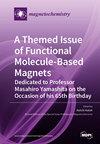通过调整嵌入氮化钛薄膜中铁纳米颗粒的尺寸依赖性磁热效应来增强磁冷却
IF 2.6
4区 化学
Q2 CHEMISTRY, INORGANIC & NUCLEAR
引用次数: 0
摘要
利用脉冲激光沉积技术(PLD)制备氮化钛(TiN)薄膜基质,研究了铁(Fe)纳米颗粒的磁热效应(MCE)。该研究证明了通过改变铁纳米颗粒的尺寸来控制磁相变熵变化的能力。利用x射线衍射(XRD)、扫描电镜(SEM)、原子力显微镜(AFM)和扫描透射电子(TEM)对TiN薄膜进行了结构表征,结果表明TiN薄膜呈(111)织构,而fe颗粒大多呈球形,为单晶,并与周围的TiN薄膜基体具有相干结构。选择TiN薄膜基质作为间隔层,因为它是非磁性的,具有很强的耐腐蚀性,并且由于其高导热系数(11 W/m K),可以作为一个很好的管道来提取热量。使用超导量子干涉装置(SQUID)磁强计研究了Fe-TiN系统的磁性能。利用面内磁场记录磁化强度与场的关系(M-H)和磁化强度与温度的关系(M-T)曲线。结果表明,Fe - tin异质结构体系在从室温到Fe纳米颗粒阻滞温度的较宽温度范围内表现出明显的等温熵变(ΔS)。利用麦克斯韦关系,分析不同磁场下的磁化温度数据,对Fe-TiN异质结构体系的等温熵变(ΔS)和磁热效应(MCE)进行了定量分析。该研究指出,对于纳米颗粒尺寸为7 nm的样品,在0.2 T和300 K时,ΔS的负变化可达0.2 J/kg K。对比分析表明,纳米铁比多层铁薄膜具有更高的制冷能力,且制冷能力随纳米铁粒径的减小而增大。这些发现为Fe-TiN异质结构在固态冷却技术中的潜在应用提供了有价值的见解,突出了它们增强的磁热学性能。本文章由计算机程序翻译,如有差异,请以英文原文为准。
Enhanced Magnetic Cooling through Tailoring the Size-Dependent Magnetocaloric Effect of Iron Nanoparticles Embedded in Titanium Nitride Thin Films
The magnetocaloric effect (MCE) in iron (Fe) nanoparticles incorporated within a titanium nitride (TiN) thin-film matrix grown using pulsed laser deposition (PLD) is investigated in this study. The study demonstrates the ability to control the entropy change across the magnetic phase transition by varying the size of the Fe nanoparticles. The structural characterization carried out using X-ray diffraction (XRD), scanning electron microscopy (SEM), atomic force microscopy (AFM), and scanning transmission electron (TEM) showed that TiN films are (111) textured, while the Fe-particles are mostly spherical in shapes, are single-crystalline, and have a coherent structure with the surrounding TiN thin-film matrix. The TiN thin-film matrix was chosen as a spacer layer since it is nonmagnetic, is highly corrosion-resistive, and can serve as an excellent conduit for extracting heat due to its high thermal conductivity (11 W/m K). The magnetic properties of Fe–TiN systems were investigated using a superconducting quantum interference device (SQUID) magnetometer. In-plane magnetic fields were applied to record magnetization versus field (M–H) and magnetization versus temperature (M–T) curves. The results showed that the Fe–TiN heterostructure system exhibits a substantial isothermal entropy change (ΔS) over a wide temperature range, encompassing room temperature to the blocking temperature of the Fe nanoparticles. Using Maxwell’s relation and analyzing magnetization–temperature data under different magnetic fields, quantitative insights into the isothermal entropy change (ΔS) and magnetocaloric effect (MCE) were obtained for the Fe–TiN heterostructure system. The study points out a considerable negative change in ΔS that reaches up to 0.2 J/kg K at 0.2 T and 300 K for the samples with a nanoparticle size on the order of 7 nm. Comparative analysis revealed that Fe nanoparticle samples demonstrate higher refrigeration capacity (RC) in comparison to Fe thin-film multilayer samples, with the RC increasing as the Fe particle size decreases. These findings provide valuable insights into the potential application of Fe–TiN heterostructures in solid-state cooling technologies, highlighting their enhanced magnetocaloric properties.
求助全文
通过发布文献求助,成功后即可免费获取论文全文。
去求助
来源期刊

Magnetochemistry
Chemistry-Chemistry (miscellaneous)
CiteScore
3.90
自引率
11.10%
发文量
145
审稿时长
11 weeks
期刊介绍:
Magnetochemistry (ISSN 2312-7481) is a unique international, scientific open access journal on molecular magnetism, the relationship between chemical structure and magnetism and magnetic materials. Magnetochemistry publishes research articles, short communications and reviews. Our aim is to encourage scientists to publish their experimental and theoretical results in as much detail as possible. Therefore, there is no restriction on the length of the papers. The full experimental details must be provided so that the results can be reproduced.
 求助内容:
求助内容: 应助结果提醒方式:
应助结果提醒方式:


